系统分析与设计方法 影印版 第七版 (Lonnie D.Bentley Jeffrey L.Whitten) 课后答案[1-4章].khda
软考系统架构设计教材 信息系统软考
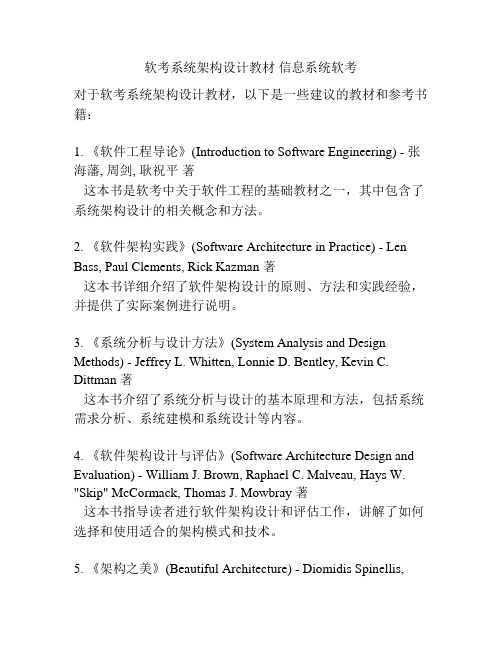
软考系统架构设计教材信息系统软考对于软考系统架构设计教材,以下是一些建议的教材和参考书籍:1. 《软件工程导论》(Introduction to Software Engineering) - 张海藩, 周剑, 耿祝平著这本书是软考中关于软件工程的基础教材之一,其中包含了系统架构设计的相关概念和方法。
2. 《软件架构实践》(Software Architecture in Practice) - Len Bass, Paul Clements, Rick Kazman 著这本书详细介绍了软件架构设计的原则、方法和实践经验,并提供了实际案例进行说明。
3. 《系统分析与设计方法》(System Analysis and Design Methods) - Jeffrey L. Whitten, Lonnie D. Bentley, Kevin C. Dittman 著这本书介绍了系统分析与设计的基本原理和方法,包括系统需求分析、系统建模和系统设计等内容。
4. 《软件架构设计与评估》(Software Architecture Design and Evaluation) - William J. Brown, Raphael C. Malveau, Hays W. "Skip" McCormack, Thomas J. Mowbray 著这本书指导读者进行软件架构设计和评估工作,讲解了如何选择和使用适合的架构模式和技术。
5. 《架构之美》(Beautiful Architecture) - Diomidis Spinellis,Georgios Gousios 著这本书介绍了当代软件系统架构的设计原则、实践和案例,展示了一些优秀的软件系统架构的设计思路和方法。
除了以上的书籍,还可以参考一些软考相关的教材和题库,例如《软考信息系统项目管理试题与答案解析》、《软考系统分析与设计试题与答案解析》等,这些教材和题库中通常会包含一些关于系统架构设计的题目和解析。
《系统分析与设计方法》读后感

浅谈《系统分析与设计方法》《系统分析与设计方法》,顾名思义,是论述软件开发过程中涉及到的分析与设计过程的方法论。
作者依照软件开发过程将书划分为四个部分:系统开发项目环境、系统分析方法、系统设计方法、系统分析和设计完成后的工作。
同其他美国作者一样,作者通过一个贯穿全书的案例--音阶公司系统项目,向我们详细地讲解了开发一个软件系统过程中设计到的知识。
第一部分“系统开发项目环境”介绍信息系统开发的概念和过程。
第二部分“系统分析方法”涵盖了生命周期前期活动、工具和技术,这些内容用于分析业务问题、说明信息系统业务需求以及制定业务和系统方案。
第三部分“系统设计方法”涵盖了生命周期中期活动、工具和技术,特别强调应用架构的概要设计和详细设计、快速开发和原型设计、外部设计(输出、输入和界面)、内部设计(如数据库和软件工程)以及面向对象设计。
第四部分“系统分析和设计完成后的工作”通过纵览生命周期后期活动,透视系统分析和设计工作。
读完这本,我不仅收获了如何进行系统分析与设计的指导思想,学会了UML工具等,更对一个软件系统的从需求分析到后期的运行、维护的整套工作流程有了一个概括的认识,了解了各阶段的需要撰写哪些文档,学会了如何与各种人员进行交流等待。
但这本书给我启发最深的不是技术方面的知识,而是让我对软件工程有了一个更为深入、透彻的认识。
早在20世纪中期,计算机刚被参军用范畴转向民用范畴运用,那时编写程序的工作被视同为艺术家的创作。
由于硬件资源的限制,编程人员追求的是如何在有限的处置器才能和存储器空间约束下,编写出执行速度快、体积小的程序,所有这时的软件开发十分依赖于开发人员的聪明才智。
而到了20世纪60年代,计算机的应用范围得到较大扩展,对软件系统的需求和软件本身的复杂度急剧上升,传统的开发办法无法顺应用户在质量、效率等方面对软件的需求。
这就是所谓的“软件危机”。
为了解决这个问题,便引入了“软件工程”这一概念,从而开始了软件开发从“艺术”和“个体行为”向“工程”和“群体协同工作”的转化。
系统分析与设计方法的前四章课后作业

系统分析与设计方法课后作业系别:-------------班级:--------------学号:--------------学生姓名:--------------任课教师:--------------Chapter One3. Who are the typical stakeholders in an information system? What are their roles?Information workers are the stakeholders in information systems. Information workers include those people whose jobs involve the creation, collection, processing, distribution, and use of information. They include:a. System owners, the sponsors and chief advocates of information systems.b. System users, the people who use or are impacted by the information system on a regular basis. Geographically, system users may be internal or external.c. System designers, technology specialists who translate system users’ busi ness requirements and constraints into technical solutions.d. System builders, technology specialists who construct the information system based on the design specifications.e. Systems analysts, who facilitate the development of information systems and computer applications. They coordinate the efforts of the owners, users, designers, and builders.6. What are the differences between the role of system analysts and the role of the rest of the stakeholders?The systems analysts coordinate the efforts of the owners, users, designers, and builders. Frequently, they may play one of those roles as well. System analysts perform systems analysis and design.7. What kind of knowledge and skills should a system analyst possess?a. Working knowledge of information technologies.b. Computer programming experience and expertise.c. General knowledge of business processes and terminology.d. General problem-solving skills.e. Good interpersonal communication skills.f. Good interpersonal relations skills.g. Flexibility and adaptability.h. Character and ethics.9. Why are good interpersonal communication skills essential for system analysts? An analyst must be able to communicate effectively, both orally and in writing. Almost without exception, your communications skills, not your technical skills, will prove to be the single biggest factor in your career success or failure. These skills are learn-able, but most of us must force ourselves to seek help and work hard to improve them. Most schools offer courses such as business and technical writing,business and technical speaking, interviewing, and listening—all use-ful skills for the systems analyst.10. What are some of the business drivers for today’s information systems? Business drivers influence information systems.Current business drivers that will continue to influence the development of information systems include:a. Globalization of the economy.b. Electronic commerce and business.c. Security and privacy.d. Collaboration and partnership.e. Knowledge asset management.f. Continuous improvement and total quality management.g. Business process redesign.13. What are the most important technology drivers for today’s information systems?Information technology can be a driver of information systems. Outdated technologies can present problems that drive the need to develop new systems. Newer technologies such as the following are influencing today’s information systems:a. Networks and the Internet:i) xHTML and XML are the fundamental languages of Web page authoring and Internet application development. Extensible Hypertext Markup Language (xHTML) is the emerging second-generation version of HTML, the language used to construct Web pages. Extensible Markup Language (XML) is the language used to effectively transport data content along with its proper interpretation over the Internet.ii) Scripting languages are simple programming languages designed specifically for Internet applications.iii) Web-specific programming languages such as Java and Cold Fusion have emerged to specifically address construction of complex, Web-based applications that involve multiple servers and Web browsers.iv) Intranets are essentially private Internets designed for use by employees of an organization. They offer the look and feel of the Internet; however, security and fire-walls restrict their use to employees.v) Extranets, like intranets, are private Inter-nets. But extranets are for use between specific organizations. Only the employ-ees of those identified businesses can access and use the extranet.vi) Portals(in corporations) are “home pages” that can be customized to the specific needs of different individuals who use them. For example, portal technologycan define Web pages that pro-vide appropriate information and applications for different roles in the same company. Each individual’s role determines which information and applications that person can use from her or his Web page.vii) Web services are reusable, Web-based pro-grams that can be called from any other Internet program.b. Mobile and wireless technologies—Increasingly, wireless access must be assumed. And the limitations of mobile devices and screen sizes must be accommodated in an information system’s design. All of the following tech-nical trends will significantly impact the analysis and design of new information systems:i) Handheld computers, or personal data assistants (such as the HP iPaq, Palm, and RIM Blackberry ) have become common in the ranks of information workers. These devices are increasingly including wireless capabilities that provide Web access and e-mailii) Cell phones are also increasingly featuring Internet and e-mail capabilities.iii) Integrated devices such as smart phones are emerging that integrate the capabilities of PDAs and cell phones into a single device.iv) Technologies like Bluetoothare emerging to allow separate devices to interoperate as one logical device while preserving each one’s form factors and advantages.c. Object technologies —Most contemporary information systems are built using object technologies. Object technologies allow programmers to build software from software parts called objects. Object-oriented software offers the advantage of reusability and extensibility.d. Collaborative technologies—Collaborative technologies are those that enhance interpersonal communications and teamwork. Four important classes of collaborative technologies are e-mail, instant messaging, groupware, and work flow.e. Enterprise applications—Virtually all organizations, large and small, require a core set of enterprise applications to conduct business. For most businesses the core applications include financial management, human resource management, marketing and sales, and operations management (inventory and/or manufacturing control).At one time, most organizations custom-built most or all of these core enterprise applications. But today, these enterprise applications are frequently purchased, in-stalled, and configured for the business and integrated into the organization’s business processe s. These “internal” core applications are being supplemented with other enterprise applications that integrate an organization’s business processes with those of its suppliers and customers. These applications are called customer relationship management (CRM) and supply chain management (SCM). Enterprise application integration (EAI) involves linking applications, whether purchased ordeveloped in-house, so that they can transparently inter-operate with one another.3. Career choices and personal skills:a. At this point in your education, if you had to choose between becoming a systems analyst, systems designer, or systems builder, which one would you choose?Systems analyst.b. Why?Because I am interested in the job.c. Now divide a piece of paper into two columns. On one side, list the personal skills and traits you think are most important for each of these three groups of systems analysts, designers, and builders. In the second column, list at least five skills and traits that you feel to be your strongest ones, then map them to the skills and traits you listed for each of the three groups. With which group do you haved. Is this group the same one as the one you would choose in Question 3a? Why do you think this is (or is not) the case?Yes.Chapter Two2. How do transaction processing systems (TPSs), management information systems (MISs), and decision support systems (DSSs) interact with each other?The many classes of information system applications overlap and interoperate to complement and supplement one another.3. Why do we need to identify the information system architecture?Different stakeholders have different perspectives on or views of an information system.They must be carefully synchronized to avoid inconsistencies and incompatibilities within the system.4. What are the three business goal–oriented perspectives or views of an information system that systems owners and system users tend to focus on? What are the three technological perspectives that system designers and builders tend to focus on?a. System owners and system users tend to focus on three common business goals of any information system—improvements in business knowledge, businessprocesses, and business communications.b. System designers and builders tend to focus on technologies used by the information system in order to achieve the business goals. They focus on the database technologies that support business knowledge, software technologies that support business processes, and interface technologies that support business communications.8. Understanding business functions is essential in the process building block of an information sys-tem. What are six high-level business functions typical of many companies?•Sales•Service•Manufacturing•Shipping•Receiving•Accounting11. What is prototyping? Why do we need such a technique?a. Prototyping: a technique for quickly building a functioning but incomplete model of the information system using rapid application development tools.b. Prototyping has become the design technique of choice for many system designers and builders. Prototypes typically evolve into the final version of the system or application.1. Companies generally need to use more than one information system to support all their different business functions. These functions are frequently referred to as either front-office information systems or back-office systems. Define each of these two types of systems and identify some of the typical business functions supported by them.a. Front-office information systems that support business functions that extend out to their customers and back-office information systems that support internal business operations and interact with suppliers.b. Front-office information systems:•Marketing Information System•Sales Information System•Customer Management Information SystemBack-office information systems:•Human Resources Information System•Financial Information System•Manufacturing Information System•Inventory Information System2. As a systems analyst, designer, or builder, you will frequently be involved with your organization’s information systems architecture. What is an information systems architecture, and what is its purpose?a. Information systems architecture: a unifying framework into which various stakeholders with different perspectives can organize and view the fundamental building blocks of information systems.b. An information systems architecture serves as a higher-level frame-work for understanding different views of the fundamental building blocks of an information system.6. Assume you are designing a retail point-of-sale (POS) system for your company. What are the typical system interfaces of a point-of-sale system that need to be taken into account in designing the POS system?Such as human resources, order resources, goods resource, saling, and accounts payable.8. Middleware is frequently used in systems integration projects when different information systems are tied together to exchange data via system-to-system interfaces. Briefly define middleware, ex-plain its benefits, and provide an example.a. Middleware utility software that allows application soft-ware and systems software that utilize differing technologies to interoperate.b. Middleware is a layer of utility software that sits in be-tween application software and systems software to transparently integrate differing technologies so that they can interoperate.c. One common example of middleware is the open database connectivity (ODBC) tools that allow application programs to work with different database management systems without having to be rewritten to take into consideration the nuances and differences of those database management systems. Programs written with ODBC commands can, for the most part, work with any ODBC-compliant database (which includes dozens of different database management systems). Similar middleware products exist for each of the columns in our information system framework. System designers help to select and apply these products to integrate systems.12. System designers frequently have a number of technical design options to choose from when designing interfaces between different systems and applications. What should designers always keep in mind when designing these interfaces?(1) Do not create maintenance projects for the legacy systems(2) Do not compromise the superior technologies and design of the new systems a(3) And are ideally transparent to the system users.14. At times, an organization may choose to purchase a commercial off-the-shelf (COTS) software package. What do you think are the pros and cons of using off-the-shelf applications compared to custom-built applications?Chapter Three2. How are system life cycle and system development methodology related?A system life cycle divides the life of an information system into two stages, systems development and systems operation and maintenance.A systems development methodology is a process for the system development stage. It de-fines a set of activities, methods, best practices, deliverables, and automated tools that systems developers and project managers are to use to develop and maintain information systems and software.3. What are the 10 underlying principles for systems development?The following principles should underlie all systems development methodologies:a. Get the system users involved.b. Use a problem-solving approach.c. Establish phases and activities.d. Document throughout development.e. Establish standards.f. Manage the process and projects.g. Justify information systems as capital investments.h. Don’t be afraid to cancel or revise scope.i. Divide and conquer.j. Design systems for growth and change.9. What are the three most important deliverables in scope definition?•Problem statement. A statement and categorization of problems, opportunities, and directives; may also include constraints and an initial vision for the solution. Synonyms include preliminary study and feasibility assessment.•Scope statement. Scope defines how big we think the project is. Your information system building blocks provide a useful framework for defining scope. Scope can, and frequently does, change during a project. But by documenting initial scope, you establish a baseline for controlling scope creep on both the budget and the schedule. •Statement of work. A contract with management and the user community to develop or enhance an information system; defines vision, scope, constraints, high-level user requirements, schedule, and budget. Synonyms include project charter, project plan, and service-level agreement.12. What is model-driven development?Model-driven development strategies, which emphasize the drawing of diagrams to help visualize and analyze problems, define business requirements, and design information systems. Alternative model-driven strategies include:i) Process modelingii) Data modelingiii) Object modeling13. Why is model-driven development popular?System models can be produced as a portion of the deliverables for most phases. Model-driven approaches emphasize system modeling. Once implemented, the system models serve as documentation for any changes that might be needed during the operation and support stage of the life cycle.The model-driven approach is believed to offer several advantages as listed below: •Requirements specification tends to be more thorough and better documented. •Business requirements and system designs are easier to validate with pictures than words.•It is easier to identify, conceptualize and analyze alternative technical solutions. •Design specifications tend to be more sound, stable, adaptable, and flexible because they are model based and more thoroughly analyzed before they are built. •Systems can be constructed more correctly the first time when built from thorough and clear model based specifications. Some argue that code-generating software can automatically generate skeleton or near-complete code from good system models.Model-driven development is most effective for systems for which requirements are well understood and which are so complex that they require large project teams to complete. The approach also works well when fulfillment of user expectations and quality is more important than cost and schedule.14. What is rapid application development (RAD)?Rapid application development (RAD) strategies, which emphasize extensive user involvement in the rapid and evolutionary construction of working prototypes of a system to accelerate the system development process.Chapter Four4. What are the five main categories of competencies that a project manager should have?6. What are the basic project management functions?These functions include scoping, planning, staffing, organizing, scheduling, directing, controlling, and closing:•Scoping—Scope defines the boundaries of the project. A project manager must scope project expectations and constraints in order to plan activities, estimate costs, and manage expectations.•Planning—Planning identifies the tasks required to complete the project. This is based on the manager’s understanding of the project scope and the methodology used to achieve the goal.•Estimating —Each task that is required to complete the project must be estimated. How much time will be required? How many people will be needed? What skills will be needed? What tasks must be completed before other tasks are started? Can some of the tasks overlap? How much will it cost? These are all estimating issues. Some of these issues can be resolved with the project modeling tools that will be discussed later in this chapter.•Scheduling —Given the project plan, the project manager is responsible for scheduling all project activities. The project schedule should be developed with an understanding of the required tasks, task duration, and task prerequisites.•Organizing —The project manager should make sure that members of the project team understand their own individual roles and responsibilities as well as their reporting relationship to the project manager.•Directing—Once the project has begun, the project manager must direct the team’s activities. Every project manager mus t demonstrate people management skills to coordinate, delegate, motivate, advise, appraise, and reward team members.•Controlling —Perhaps the manager’s most diff icult and important function is controlling the project. Few plans will be executed without problems and delays. The project manager must monitor and report progress against goals, schedule, and costs and make appropriate adjustments when necessary.•Closing—Good project managers always assess successes and failures at the conclusion of a project. They learn from their mistakes and plan for continuous improvement of the systems development process.8. What are the eight major activities in the project management life cycle? •Negotiate scope. Scope defines the boundaries of a project and is included in the statement of work, a narrative description of the work to be performed as part of a project.•Identify tasks. A work breakdown structure (WBS) is a hierarchical decomposition of the project into its tasks and subtasks. Some tasks represent the completion of milestones or the completion of major deliverables during a project.•Estimate task durations. There are many techniques and tools for estimating task durations.•Specify intertask dependencies. The start or completion of individual tasks may be dependent on the start or completion of other tasks. These dependencies impact the completion of any project.•Assign resources. The following resources may impact a project schedule: people, services, facilities and equipment, supplies and materials, and money.i) Such resources must be assigned to tasks to develop a schedule.ii) Resource leveling is a strategy used to correct resource over allocations by some combination of delaying or splitting tasks. Resource leveling requires knowledge of:(1) The critical path—that sequence of de-pendent tasks that have the largest sum of most likely durations. The critical path determines the earliest possible completion date of the project.(2) Slack time—the amount of delay that can be tolerated between the starting time and completion time of a task without causing a delay in the completion date of the entire project.•Direct the team effort. One of the most important dimensions of directing the team effort is the supervision of people.•Monitor and control progress. During the project, the project manager must monitor project progress against the scope, schedule, and bud-get and, when necessary, make adjustments to scope, schedule, and resources.i) Progress reporting is an essential control process that uses communication to keep a project within scope, on time, and within budget.ii) A complete project plan provides mechanisms and a process to manage requests for changes to scope. This is called change management.iii) Change management frequently requires that a project manager manage the expectations of management and users themselves. An expectations management matrix is a rule-driven tool for helping management under-stand the dynamics and impact of changing project parameters such as cost, schedule, scope, and quality.iv) Schedule adjustments are required when a project’s scope changes or when other fac-tors drive schedule or budget out of the projected range.•Assess project results and experiences. This final activity involves soliciting feedback from project team members (including customers) concerning their project experiences and suggestions aimed at improving the project and process management of the organization.10. What is a popular tool used to identify tasks in the project management life cycle?One popular tool used to identify and document project activities and tasks is a work breakdown structure. A work breakdown structure (WBS) is a hierarchical decomposition of the project into phases, activities, and tasks.11. What are the factors to consider in estimating task durations?In estimating task duration, it is important to understand the concept of elapsed time. Elapsed time takes into consideration two important factors with respect to people: •Efficiency—No worker performs at 100 percent efficiency. Most people take coffee breaks, lunch breaks, restroom breaks, and time to read their e-mail, check their calendars, participate in nonproject work, and even engage in idle conversation. Experts differ on just how productive the average worker is, but one commonly used figure is 75 percent.•Interruptions —People experience phone calls, visitors, and other unplanned interruptions that increase the time required for project work. This is variable for different workers. Interruptions can consume as little as 10 percent of a worker’s day or as much as 50 percent.13. What are the categories of resources to be allocated to the project?We have yet to consider the allocation of resources to the project. Resources includethe following categories:•People —includes all the system owners, users, analysts, designers, builders, external agents, and clerical help that will be involved in the project in any way. •Services—includes services such as a quality review that may be charged on a per-use basis.•Facilities and equipment—includes all rooms and technology that will be needed to complete the project.•Supplies and materials—includes everything from pencils, paper, and note-books to toner cartridges, and so on.•Money —includes a translation of all of the above into budgeted dollars!13. You have been asked to complete a project in shortest time possible. The project tasks, most likely duration (in days), and predecessors are shown below. What are the different paths (sequence of tasks) and the number of days for each? What is the critical path, that is, the shortest time in which the project can be completed? Is it actually important in the business world for project managers to understand critical path analysis, or is this just theoretical knowledge?。
系统分析与设计方法

系统分析与设计方法系统分析与设计(System Analysis and Design,SAD)方法是一种通过对系统需求进行分析和设计,来开发和改进软件和信息系统的方法。
该方法包含多个步骤和技术工具,以确保系统能够满足用户需求并具有高效和可靠的性能。
以下是系统分析与设计方法的一般流程:1. 系统需求分析:收集用户需求,了解业务流程,并确定系统的功能需求和性能要求。
2. 系统设计:在需求分析的基础上,设计系统的整体架构和组件之间的关系。
这包括确定系统的模块、数据结构和界面设计。
3. 数据建模:使用数据建模技术,如实体关系图(ER图)或类图,来描述系统中的数据流和数据关系。
4. 程序设计:根据系统设计,编写系统的程序代码。
这包括选择合适的编程语言和工具,并遵循良好的编程规范和设计原则。
5. 系统集成与测试:将系统的各个组件进行集成,并对系统进行测试。
这包括单元测试、集成测试和系统测试,以确保系统的功能和性能符合要求。
6. 系统实施与部署:将系统部署到生产环境,并对系统进行运行和维护。
这包括安装系统、培训用户和支持系统的正常运行。
7. 系统维护与改进:定期检查系统的性能和功能,修复系统中的错误和漏洞,并根据用户反馈和需求进行系统改进和升级。
在系统分析与设计的过程中,还可以使用一些常见的工具和技术,如需求调研、用例图、数据流图、状态图、原型设计、迭代开发等,来提高开发效率和系统质量。
总的来说,系统分析与设计方法是一套系统化的方法论,旨在确保开发的软件和信息系统能够满足用户需求,具有高效和可靠的性能。
它是软件开发和信息系统管理中重要的环节,能够提高系统的质量和用户满意度。
最新1绪论系统分析与设计课件教学讲义ppt课件
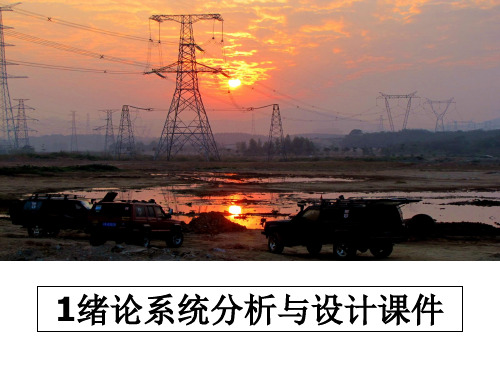
• 保护公众健康和环境安全的法律强制专业人员必须提供指导,这 些指导通常是从教育和经验中,以惨痛的教训和国家立法的形式 获得的
• 即使有了严格的检测和许可证的发给,工程灾难还是会经常发生。 因此专业工程师必须严守工程伦理学标准
• 每个工程学科和专业组织,都持有普遍公共的和特定相关领域的 伦理学标准,成员必须发誓遵守并维护
• 工程是由一群人为达到某种目的,在一个 较长时间周期内,进行协作活动的过程— —广义定义
• 工程是将自然科学的理论应用到具体工农 业生产部门中形成的各学科的总称
– 水利工程、化学工程、土木建筑工程、遗传工程、 系统工程、生物工程、海洋工程、环境微生物工 程、软件工程
10
工程学
• 工程学或工学,是通过研究与实践应用数学、自然科学、经济学、 社会学等基础学科的知识,来达到改良各行业中现有建筑、机械、 仪器、系统、材料、信息和加工步骤的设计和应用方式的一门学 科
– 研究:应用数学和自然科学概念、原理、实验技术等,探求新的工作原理和方法 – 开发:解决把研究成果应用于实际过程中所遇到的各种问题 – 设计:选择不同的方法、特定的材料并确定符合技术要求和性能规格的设计方案,
以满足结构或产品的要求 – 施工:包括准备场地、材料存放、选定既经济又安全并能达到质量要求的工作步
中 • 所谓最佳设计,永远意味着,尽可能达到尽可能多的要求
13
解决问题
• 工程师一般在全面生产过程前,就尝试预测他们的设计如何达到规格 • 他们会使用:原型、比例模型、模拟、破坏性试验、非破坏性试验、
强度测试等方法来完成设计 • 并对产品进行测试,以保证产品能按期望值运行 • 当然,测试的目地是确保产品能符合预计的要求 • 工程师作为专业人员会尽量制造符合预计要求的产品,并达到对社会
管理学原理与方法第七版习题与案例指南
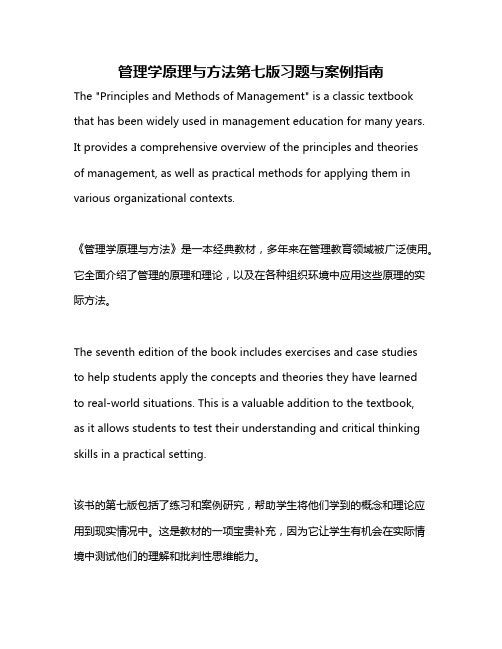
管理学原理与方法第七版习题与案例指南The "Principles and Methods of Management" is a classic textbook that has been widely used in management education for many years. It provides a comprehensive overview of the principles and theoriesof management, as well as practical methods for applying them in various organizational contexts.《管理学原理与方法》是一本经典教材,多年来在管理教育领域被广泛使用。
它全面介绍了管理的原理和理论,以及在各种组织环境中应用这些原理的实际方法。
The seventh edition of the book includes exercises and case studiesto help students apply the concepts and theories they have learnedto real-world situations. This is a valuable addition to the textbook,as it allows students to test their understanding and critical thinking skills in a practical setting.该书的第七版包括了练习和案例研究,帮助学生将他们学到的概念和理论应用到现实情况中。
这是教材的一项宝贵补充,因为它让学生有机会在实际情境中测试他们的理解和批判性思维能力。
Furthermore, the exercises and case studies provide a bridge between theory and practice, helping students develop the skills they need to be successful managers in the future. By working through these exercises and analyzing the case studies, students can gain a deeper understanding of how management principles are applied in real-world situations.此外,练习和案例研究提供了理论与实践之间的桥梁,帮助学生培养他们未来成功成为管理者所需的技能。
系统分析与设计方法概述

Step 10: 系统将该图书号、该读者的借书证号、以及借书日期信息为新的借阅记录 登记到借阅记录文件中,并根据借阅期限规定,对借阅记录确定应还日期;显示本 次产生的借阅记录,询问读者是否继续借书
Step 11: 读者确定“是/否”继续提交新的借阅请求; 读者确定“ 否 继续提交新的借阅请求;
Step 12: If 读者点击“否”,说明已经完成了所有的借阅请求 读者点击“ 向读者提交所有本次人借阅的汇总清单,本次 向读者提交所有本次人借阅的 ,本次借阅过程结束 结束 Else 重复Step 7~ 12 重复
传奇之声
谢谢Байду номын сангаас家
实例介绍(一个小型的图书管理系统 基本模型) 实例介绍(一个小型的图书管理系统UML基本模型) 基本模型
系统用例图
用例图在UML中是 中是 用例图在 非常独特的图形元 素,它描述人们希 望如何使用一个系 统。用例图告诉我 们谁将是相关的用 户,他们希望系统 提供什么样的服务, 提供什么样的服务, 以及他们需要为系 统提供的服务。 统提供的服务。
借书过程类图
类图以图形化的方式用来描述对象及 其关联关系
面对读者的借书系统模型
借书行为用例说明 借书行为用例说明
参与者行为 Step 1: 读者提出点击“借书”按钮,提出借阅请求;
系统响应
Step 2: 系统做出响应,要求用户输入借书证号;
Step 3: 读者输入借书证号;
Step 4: 系统访问文件中存储的读者记录,根据借书证号确认该读者是合法借阅者;
系统分析 与设计
建立信息系统的人员组成
系统所有者和系统用户 系统所有者和系统用户
系统设计人员和系统构造人员
信息技术厂商和咨询顾问
系统分析的方法与技术新版ppt

18
1.4 系统分析的方法与技术
价值研究
要回答的问题
喜好什么?为什么目的?许诺什么 ?应优先考虑什么?……
基本科学推断
该系统的偏好是…… 经过考虑系统的偏好是……
基本目标
确认某个目标时候值得争取,采取 的手段时候能被接受以及改进系统 的结果是否良好。
19
1.4 系统分析的方法与技术
规范研究
要回答的问题 应该是什么?应该怎么样?……
运用系统的思想分析 啤酒游戏恶性循环的 原因是什么?
如何改善啤酒游戏的 绩效
24
关键术语
系统 系统分析 系统分析的基本内容、逻辑过程
系统分析的基本原则 整体性原则 优化原则 模型化原则 层次 性原则
行为研究 价值研究 规范研究 可行性研究
价值分析 可行性分析 超理性因素分析 交叉文化因素分析 确定型分析 随机型分析
5 有助于开拓新的知识领域,从不同角度提出问题
4
6 促使人们进行对从目的到手段、从内到外的调查
4
7
1.1 系统与系统技术
1.1.4 系统分析的局限性
当某些活动的目的是以下情况时,不适宜用系统分析。
通过剧烈冲 击而引起系 统快速变化
目的是破 坏而不是 维护
目的是加强 权力,保持 一致
对人和社会 的驱动力来
1.4.3 系统分析的定量分析方法
帮助人们理解系统并进行系统之间的比较
定量方法的作用 变量、限制条件和选择都是已知的、确定的;
促使人们进行对从目的到手段、从内到外的调查
常出现的问题
4 系统分析的方法与技术
对人和社会的驱动能力是来有自社关会知意识识形条态理等化 组2 织系因统素分如析民的主定与性,集分专中析门、方权法化威(,和若是领干导方量能法的力介比等绍。)
(管理信息系统第七版-第5章)管理信息系统的系统分析

2.系统设计
信息系统设计包 括两个部分,也 即信息系统的逻 辑设计和物理设 计。
3.系统实施
包括编写和调试 程序、编写技术 文件、系统转换、 系统运行和系统 评价等。
系统分析
系统实施
系统设计
2022/1/28
第五章 管理信息系统的系统分析
4
1.1 系统开发的生命周期法
生命周期法的优缺点如下:
优点:对于大系统或系统 缺点:生命周期法的不足
3.管理业务 流程调查
1.组织结构 调查
2.管理功能 调查
2022/1/28
管理业务调查应遵循用户参与的原则,即由使用部门的业务人员、主管人 员和设计部门的系统分析人员、系统设计人员共同进行。调查的方法可 以采用:(1) 召开调查会;(2) 访谈;(3) 发调查表;(4) 参加业务实践; (5)收集资料。
2.系统设计 系统设计阶段是在系统分析提出的逻辑模型的基础上设计系统的物理模型,解决系统 “怎么做”问题。其主要内容包括:代码设计、信息系统流程图设计、数据库设计、处理 流程图设计和编写程序设计说明书等。系统设计阶段的成果是“系统设计说明书”。
3.系统实施 系统实施阶段的内容包括程序设计及调试、系统转换及系统运行与评估等环节。这一阶 段的成果,除了最终实现的管理信息系统外,还包括有关的技术文档(如程序说明书、使用 说明书等)。
开发缺乏经验的情况,采 之处是系统的开发周期太
用生命周期法可以立足全 长。有时,系统开发尚在
局,步步为营,减少返工,开发过程之中,而内外环
有利于提高开发质量,加 境已有所变化,对系统的
快工程进度。
需求也发生了变化。
所以说:生命周期法的优点是调查工作可以做得很深入,系统性较好; 缺点是开发周期太长。
数值分析(浙江大学)全套课件

数值分析 (第七版 影印版)
Richard L. Burden & J. Douglas Faires (高等教育出版社)
ห้องสมุดไป่ตู้ 学习方法
1.注意掌握各种方法的基本原理 2.注意各种方法的构造手法 3.重视各种方法的误差分析 4.做一定量的习题 5.注意与实际问题相联系
教材 (Text Book) 数值计算方法 郑慧娆等 编著 (武汉大学出版社)
参考书目 (Reference)
➢ Numerical Analysis:Mathematics of Scientific Computing (Third Edition)
数值分析 (英文版 第3版 )
David Kincaid & Ward Cheney(机械工业出版社)
10
n
0
1
102
0
10 1 101 0
2。与计算机不能分离:上机实习(掌握一 门语言:C语言,会用Matlab)
1.2 误差 ( Error )
§1 误差的背景介绍 ( Introduction ) 1. 来源与分类 ( Source & Classification ) 模型误差 ( Modeling Error ): 从实际问题中抽象出数 学模型
1 e x2 dx 0
(第七章的内容:数值积分)
数值分析的特点
1。近似: 由此产生“误差”
在计算数学和应用数学中一个有趣的问题: 什么是零?
1 10 1 10
原点附近
1
在纯数学中,认为此矩阵为满秩矩阵
10 1
但在计算数学中,它却是降秩矩阵 ?
《系统分析和设计》PPT课件

1.9 规划和模型化系统开发项目
• 选择好了开发方法后,系统开发人员必 须为需要的任务创建规划和模型。
• 一般地,开发团队使用项目管理工具来 达到最终结果。
开发方法
开发模型 项目管理工具
最终 结果
1.9.1 对比预测模型和适应模型
• 因为是预测性方法,结构化分析 把开发过程划分为一系列阶段, 叫做系统开发生命周期(SDLC) ,
1.5.2 事务处理系统
• 事务处理(TP)系统处理日常业务运行产生的数据。如客户订单处理、账目接收和保 单索赔处理等。
1.5.3 业务支持系统
• 业务支持系统为全公司不同层次的用户提供相关 工作的信息支持。这些系统可以分析事务数据、 产生管理和控制业务过程所需要的信息,为良好 决策提供信息。
• 业务支持系统能够与TP系统紧密合作。例如,当 公司向客户销售商品,TP系统记录这笔销售,更 新客户收支差额,并从库存中扣除。
1.5.6 信息系统集成
• 多数大公司需要事务处理、业务支持、知识管理 和用户生产率等系统的组合。
• 例如一个国际客户所购产品有问题并要求保单索赔,客户 服务代表把这个索赔要求输入到TP系统。这个事务更新另 外两个系统:一个是跟踪产品问题和索赔活动的知识管理 系统,另一个是有决策支持能力的质量控制系统。质量控 制引擎应用what-if分析确定是否应该做产品设计更改来减 少这种保单索赔。
• 1.7.1 建模: • 建模产生概念化或过程的图形化表示,系统开发人员可以进行分析、测试和修改。系
统分析员通过使用一系列业务、数据、对象、网络和过程模型来描述并简化信息系统 。
1.7.2 原型设计
• 原型设计可以测试系统概念并提供在做出最终决 策之前检查输入、输出和用户界面的机会。原型 是信息系统的早期版本。
Q7讲座教材

25
20
15
規格下限
10
規格上限
5
0 72.95 77.95 82.95 87.95 92.95 97.95 75.45 80.45 85.45 90.45 95.45 100.45
例:制品厚度的直方图
mm
16
4. 层別
层别是为整顿数据的思维办法 多个事物以持有相似特性的组别来分类做比较(层别),使得问题因素明了
15 10 5
11
3.2 直方图的形状:基本形
通过看分布的图形来确认数据(组)的状态,调查偏差的因素并对其进行対策。
普通工程若无习惯性或异常的状况下,产品的偏差呈正规分布。 除此以外的图形,表达会有异常发生的可能性,因此必须调查因素。 常见形式有7种。
名称 状況
(1)一般型 左右对称 (正规分布)
A
Action
P
Plan
C
D
Check
Do
管理手顺
(1) Plan 分析现状,明确目的・目的
(2) Do
按照计划实施活动
(3) Check 验证明施的成果,若成果不佳再対策
(4) Action 为使得事后不反弹而进行控制(再发避
免)
尚有在进行改善活动的基础上作为重要视点
例举下列事项
■ 用事实(数据)说话 ■ 重视过程 ■ 罗列重点 ■ 找出真因
检查日 2007/02/09
检查员 (NAME)
不良数
计
6 2 4 3
普通的流程 (1) 决定检查目的 (2) 决定表格的种类 (3) 决定检查项目 (4) 检查表作成 (5) 数据记入 (6) 累计必要的检查結果
注意 ■ 现场使用时要能够简朴记入(基本)
系统分析与设计概要
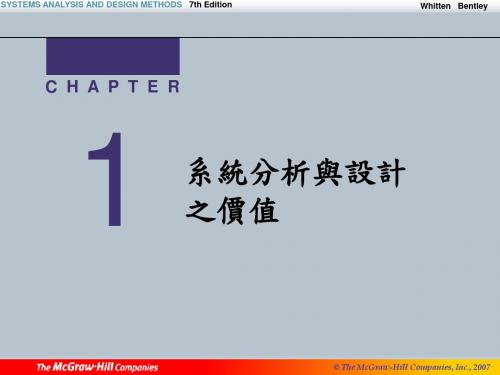
Whitten Bentley
系統分析與設計之價值
• 定義資訊系統並指出資訊系統的七種應用。 • 識別使用或發展資訊系統的各種關係人,並舉出各 種關係人的一些例子。 • 定義系統分析師在資訊系統發展中特殊的角色。 • 指出成功地扮演資訊系統分析師所需要的技能。 • 描述影響資訊系統發展之現今的企業性驅動元素。 • 描述影響資訊系統發展之現今的技術性驅動元素。 • 簡短地描述發展資訊系統的流程。
Whitten Bentley
系統設計師與系統建置者
系統設計者
將系統使用者之企業需求和限制轉換成技術性解決方案的科 技專家。她/他會設計那些符合系統使用者需求的電腦資料 庫、輸入、輸出、畫面、網路和軟體。
系統建置者
依據系統設計者產生的設計規格來建置資訊系統和元件的科 技專家。
© The McGraw-Hill Companies, Inc., 2007
一個電子商務網路店面
© The McGraw-Hill Companies, Inc., 2007
SYSTEMS ANALYSIS AND DESIGN METHODS 7th Edition
Whitten Bentley
一個電子商務採購店面
© The McGraw-Hill Companies, Inc., 2007
SYSTEMS ANALYSIS AND DESIGN METHODS 7th Edition
Whitten Bentley
資訊系統關係人之觀點
© The McGraw-Hill Companies, Inc., 2007
SYSTEMS ANALYSIS AND DESIGN METHODS 7th Edition
Whitten Bentley
系统分析与设计PPT课件
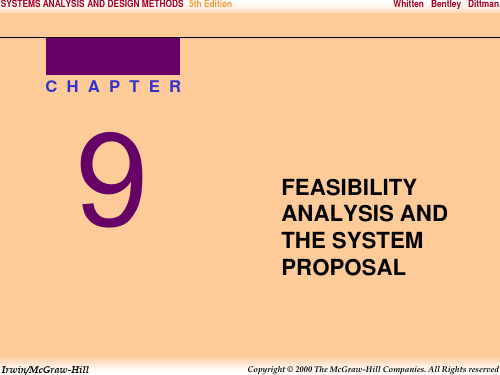
Irwin/McGraw-Hill
SYSTEMS ANALYSIS AND DESIGN METHODS 5th Edition
Whitten Bentley Dittman
CHAPTER
9
FEASIBILITY ANALYSIS AND THE SYSTEM PROPOSAL
Irwin/McGraw-Hill
Copyright © 2000 The McGraw-Hill Companies. All Rights reserved
Irwin/McGraw-Hill
Copyright © 2000 The McGraw-Hill Companies. All Rights reserved
SYSTEMS ANALYSIS AND DESIGN METHODS 5th Edition
Four Tests For Feasibility
• Identify alternative system solutions.
• Define and describe four types of feasibility and their respective criteria.
• Perform various cost-benefit analyses using timeadjusted costs and benefits.
SYSTEMS ANALYSIS AND DESIGN METHODS 5th Edition
Feasibility Analysis
系统分析与设计方法影印版第七版教学设计

系统分析与设计方法影印版第七版教学设计前言本教学设计针对《系统分析与设计方法》课程,在对该课程内容进行深入分析和研究的基础上,对课程教学进行了详细设计。
本课程旨在培养学生的系统分析和设计理论知识和实际操作技能,以及应对现场需求变更、引领项目进度控制等综合能力。
教学目标1.掌握系统分析与设计的基本概念、原理、方法和思路2.熟练掌握系统分析与设计的方法和技巧,具备应对项目需求变更、引领项目进度控制等综合能力3.具备实际项目的分析和设计能力教学大纲第一部分:系统分析概述1.1 系统分析与设计的基本概念 1.2 系统分析与设计的发展历程 1.3 系统分析与设计的目标和任务 1.4 系统分析与设计的组织与管理第二部分:系统分析方法2.1 系统分析的基本流程 2.2 系统分析的基本方法和工具 2.3 系统分析的需求分析和特征分析 2.4 系统分析的数据流图法 2.5 系统分析的结构化分析法 2.6 系统分析的面向对象方法第三部分:系统设计方法3.1 系统设计的基本流程 3.2 系统设计的基本方法和工具 3.3 系统设计的结构化设计法 3.4 系统设计的面向对象设计法 3.5 系统设计的数据设计法 3.6 系统设计的人机交互设计法第四部分:系统设计模式4.1 系统设计模式的基本概念和原理 4.2 系统设计模式的分类和应用 4.3 系统设计模式的实现和优化教学手段1.讲授与演示相结合,讲解系统分析、设计的基本概念、方法、技巧和实例演示,使学生掌握实践技巧;2.实践训练、案例分析,引导学生熟练掌握系统分析、设计中的方法、步骤和工具;3.项目实践,让学生在实际项目中运用所学知识。
实践环节设计1.设计个人作业:构建一个简单的网站系统,包括需求分析、实体关系图设计、USE CASE设计、活动图编写、详细设计和实现等部分;2.设计小组项目:组建小组进行实际项目的分析和设计工作;3.课程项目:进行基于企业实际需求的项目实践。
系统分析与设计方法-第七版-影印版

The Process Of Logical Data Modeling
• Strategic Data Modeling • Data Modeling during Systems Analysis • Looking Ahead to Systems Design • Automated Tools for Data Modeling
How to Construct Data Models
• Entity Discovery • The Context Data Model • The Key-Based Data Model • Generalized Hierarchies • The Fully Attributed Data Model
批注本地保存成功Biblioteka 通会员云端永久保存去开通Data MODELING AND Analysis
What Is Data Modeling?
Data modeling is a technique for organizing and documenting a system's data. Data modeling is sometimes called database modeling because a data model is usually implemented as a database.
Normalization
■ first normal form(1NF) an entity whose attributes have no more than one value for a single instance of that entity. ■ second normal form(2NF) an entity whose non-primary-key attributes are dependent on the full primary key. ■ third normal form(3NF) an entity whose non-primary-key attributes are not dependent on any other non-primary-key attributes.
最新FORMEL-Q第七版

Formel-Q
7.4 审核报告 / 整改计划 7.5 技术文件的标识。 7.5.1 TLD - 标识 7.5.2 供应商的标识系统 8. 供应商技术评审(TRL) 8.1 概述 8.2 实施TRL 的原因 8.3 评审前的通知 8.4 TRL 的实施 8.5 TRL 的评价 8.6 评审后的报告 9. 分供方管理(ULM) 9.1 分供方管理的目的和意义 9.2 概述 9.3 供应链中的变化 10. 问题分析(PA) 10.1 概述 10.2 实施 / 流程 10.3 风险升级原则 11. 供应商访问的文件和记录 附录
中以电子文档的方式供供应商使用。
最新有效的并有约束力的文件资料均可在上述 B2B 平台上找到。
6
Formel-Q
1、Formel-Q质量能力发展历程 2、Formel-Q第七版的主要变化 3、Formel-Q第七版的内容
7
Formel-Q
Formel-Q的主要变化
对于质量能力规定和评估的步骤将会在本册的下面几个章
节中详细阐述。
21
Formel-Q
1.引言
1.5 定级结果和后续行动
• 根据审核结果,供应商有义务分析误差产生的原因,确 定改善措施,并且确定整改完成日期及各项行动负责人。 供应商应当立即采取行之有效并可持续执行的必要措施, 且在短期内制定和实施改进计划,并确认已采取措施的
19
Formel-Q
1.引言
1.3 质量管理体系和审核结果责任
• 当大众汽车集团提出要求时,供应商有义务提供认证 / 审核的所有结果,包括自审结果。随同这些文件应当附 上已制定好的、并已开始实施的整改计划。 • 没有进行过 ISO TS 16949 或 VDA 6.1 认证的供应商必
- 1、下载文档前请自行甄别文档内容的完整性,平台不提供额外的编辑、内容补充、找答案等附加服务。
- 2、"仅部分预览"的文档,不可在线预览部分如存在完整性等问题,可反馈申请退款(可完整预览的文档不适用该条件!)。
- 3、如文档侵犯您的权益,请联系客服反馈,我们会尽快为您处理(人工客服工作时间:9:00-18:30)。
Who are the typical stakeholders in an information system?what are their roles?system ownersSystem owners is an information system s sponsor and executive advocate,usually responsible for funding the project of developing,operating,and maintaining the information system.System owners usually come from the ranks of management.For medium to large information systems,system owners are usually middle or executive managers.For smaller systems,system owners maybe middle managers or supervisors.system usersSystem user is a customer who willuse or is affected by an information system on a regular basis capturing,validating,entering,responding to,storing,and exchanging data and System users make up information workers in any information system.system designerSystem designer is a who translates system user s business requirements and constrains technical solutions.She or he designs the computer databases,inputs,screens,networks,and software that will meet the system user s requirements.system builderSystem builder is a technical specialist who constructs information systems and components based on the design specifications generated by the system designers.systems analystSystems analyst is a specialist who studies the problems and needs of an organization to determine how people,data,processes,and information technology and best accomplish improvements for the business.What are the differences between the role of system analysts and the role of the rest of the stakeholders?ing,val information.the vast major ing,entering ajority majority of the echnical technical special specialist trains into technoutputs,scr mentsSystems analysts understand both business and computing.They study business problems and opportunities and then transform business and information requirements into specifications for information systems that will be implemented by various technical specialists including computer puters and information systems are of value to a business only if they help solve problems or effect improvements.The Systems analyst is basically a problem solver.Including:problems,either real or anticipated,that require corrective action.Opportunities to improve a situation despite the absence of complaints.Directives to change a situation regardless of whether anyone has complained about the current situation.What kind of knowledge and skills should a system Working knowledge of information the analyst must be aware of both existing and emerging technologies.Computer General knowledge processes and technology system analysts must be able to with business experts to gain an understanding of and needs.General skills the system analysts must be able to take a large problem,break down that problem into its parts,determine problem causes and effects,and then recommend a solution.Good interpersonal communication skills an analyst must be able to communicate effectively,both orally and in writing.Good interpersonal relation skills.Flexibility and adaptability.Character and ethics.Why are good interpersonal communication skills essential for system analyst?An analyst must be able to communicate effectively,both orally and in writing.Almost without exception,your communication skills,not your technical skills,will prove to be the single bigger factor in your career success or failure.These skills are nformation tec amming programming experienc experience of busine business analyst posse possess?echnologies technologies information ience and expert expertisesiness processe communicate their problems oblem problem solving ess business problemlearnable,but most of us must force ourselves to seek help and work hard to improve them.What are some of the business drivers for today s information systems?Globalization of the economyElectronic commerce and businessSecurity and privacyCollaboration and partnershipKnowledge asset managementContinuous improvementTotal quality managementBusinessprocess redesignWhat are the most important technology drivers information systems?Networks and the internet Mobile and wireless Object technologiesCollaborative Enterprise applications What is the difference between front office information systems andback office information systems?Front office information system is an information system that supports business functions that extend out to the organization s customers.Back office information system is an information system that supports internal business operations of an organization,as well as reaches out to suppliers.How do transaction processing systems,management information systems,and decision support systems interact with each other?Transaction processing system responds to an input transaction s data.It techno ernetess technologies rivers for today s gieslogiestechnologies cationsdifferencproduces transaction information to verify the correct processing of the input transaction.It also produces an output transaction.Such a system may respond to something as simple as the passage of time.The management information system simply produces reports or information using data stored in transactional databases.It uses business models to produce operational management information.Decision support systems applications will typically provide read only access to the data warehouses to produce decision support and executive management information.In any given building blocks of an information system,the views of four groupsof stakeholders need to be take into account during the developmentof the system.What are these four stakeholder groups?System ownersSystem usersSystem designersSystem buildersUnderstanding business in the process building block of an information system.Want level business functions typical of many companies?SalesServiceManufacturingShippingReceivingAccountingWhat are the two most critical goals in the communication building blocks?Information systems must provide effective and efficient communication interfaces to the system s users.These interfaces should promote teamwork and coordination of activities.Information systems must interface effectively and efficiently with other elopm elopment unctions functions is esse essential are six highinformation systems both with those within the business and increasinglywith others business information systems.why has the increasing use of graphical user interfaces complicated the design process for system designers?The trend toward graphical user interfaces such as Windows and Web browsers has simplified life for system users but complicated the design process for system designers.In a typical Windows application,there are many different things users can do at any given time.Accordingly,the system designer views the interface in terms of various system states,events that change the system from one state to another,and responses to those events.Today,there are many more design decisions andthe dialogue of a graphicalWeb society has come to it is not at all uncommon and human computer server is both compellingHow related?A stageof the system life cycle.Each individual information system has its own system life cycle.The methodology is the standard process to build and maintain that system and all other information systems through their life cycles.what are the10underlying principles for systems development?Principle1:Get the system users involvedPrinciple2:Use a problem solving approachPrinciple3:Establish phases and activitiesPrinciple4:Document throughout developmentPrinciple5:Establish standardsPrinciple 6:Manage the process and projectsPrinciple 7:Justify information systems as capital investmentsPrinciple 8:Don t be afraid to cancel or revise scopePrinciple 9:Divide and conquerPrinciple 10:Design systems for growth and change what are the three most important deliverables in scope definition?One important outcome is a problem statement ,a succinct overview of the problems,opportunities,and directives that triggered the project.An initial scope statement is another important outcome of this phase.Scope defines how big we think the project is.Your information system building blocks provide auseful framework for defining scope.The final and most important deliverable is a work.Astatement of work is a contract or to the information system.what is model driven Model driven development development strategy thatemphasizes the drawing of to help visualize and analyze problems,define business requirements,and design information systems.why is model popular?Model driven is most effective for systems for whichrequirements are well understood and which are so complex that they require large project teams to complete.The approach also works well when fulfillment of user expectations and quality is more important than cost and schedule.what is rapid application development?Rapid application development is a system development strategy thatemphasizes speed of development through extensive user involvement in the rapid,iterative,and incremental construction of a serious of functioningprototypes of a system that eventually evolves into the final system.agreement development?elopment statement of developmendevelopment nt?is a system dev system models irements,requirements driven developm development developm developmentWhat are the five main categories of competencies that a project managershould have?Business achievement competencies Problem Solving competenciesInfluence competenciesPeople management competencies Self Management competencies What are the basic project management functions?Scoping setting the boundaries of the projectPlanning identifying the tasks required to complete the projectEstimating identifying the resources required to the projectScheduling developing the plan to complete Organizing making sure members roles andresponsibilitiesDirecting the Controlling monitoring progress Closing assessing success and failureWhat are the eight in the project management life cycle?Activity 1 Negotiate Scope the boundaries of a project the areas of a business that a project may (or may not)address.Includes answers to five basic questions:Project what do you what?Qualityhow good do you want it to be?Time when do you want it?Cost how much are you willing to pay for it?Resources what resource are you willing or able to bring to the table?Activity 2 Identify TasksA work breakdown structure (WBS)is a hierarchical decomposition of the project into its tasks and subtasks.Some tasks represent the completion of milestones or the completion of major deliverables during a project.unders understand inating coordinating projec project oring prog complete the projectrstand their role ojectrogressccess major activities ScopeboundarieActivity 3 Estimate Task DurationsElapsed time takes into consideration:Efficiency no worker performs at 100%efficiencyCoffee breaks,lunch,e mail,etc.Estimate of 75%is common InterruptionsPhone calls,visitors,etc.1050%Activity 4 Specify Intertask DependenciesThe start or completion of individual tasks may be dependent on the start or completion of other tasks.These dependencies impact the completion of any project.Activity 5 Assign ResourcesResources include the following People includes all owners,analysts,designers,builders,external agents,and help involved project in any way.Services includes services review that may be charged on a per use basis.Facilities and all rooms and technology that will be needed to complete Supplies and from pencils,paper,notebooks to toner cartridges,and so on.Money translation of all of the above into budgeted dollars!Activity 6 Direct the Team EffortOne of the most important dimensions of directing the team effort is the supervision of people.Activity 7 Monitor and Control ProgressProgress reporting is an essential control process that uses communication to keep a project within scope,on time,and within budget.A complete project plan provides mechanisms and a process to manage requests for changes to scope.This is called change management.Change management frequently requires that a project manager manage the expectations of management and users themselves.An expectations management matrix is a rule driven tool for helping management under stand the dynamics and impact of changing project parameters such as cost,schedule,scope,and quality.ategories:categories:system owners clerical inv such users,analys analysts olved in the uch as a quality ent equipment includes the project.projectmaterials onncludes includes a tranSchedule adjustments are required when a project s scope changes or when other fac tors drive schedule or budget out of the projected range.Activity 8 Assess Project Results and ExperiencesThis final activity involves soliciting feedback from project team members (including customers)concerning their project experiences and suggestions aimed at improving the project and process management of the organization.What is a popular tool used to identify tasks in the project managementlife cycle?One popular tool used to identify and document project activities and tasks is a work breakdown structure.A work breakdown structure (WBS)is a hierarchical decomposition of the project into phases,activities,and tasks.What are the factors to consider in estimating task durations?In estimating task duration,it is important to understand the concept of elapsed time.Elapsed time takes into consideration two important factors with respect to people:Efficiency No worker performs percent efficiency.Most people take coffee breaks,lunch breaks,to read their e mail,check their calendars,in nonproject work,and even engage in idle conversation.Experts differ on just how productive the average worker is,but one percent.Interruptions phone calls,visitors,and other unplanned interruptions the time required for project work.This isvariable for different can consume as little as 10percent of a worker s day or 50percent.What are the resources to be allocated to the project?People the system owners,users,analysts,designers,builders,external agents,and clerical help that will be involved in the project in any way.Services includes services such as a quality review that may be charged on a per use basis.Facilities and equipment includes all rooms and technology that will be needed to complete the project.Supplies and materials includes everything from pencils,paper,and note books to toner cartridges,and so on.Money includes a translation of all of the above into budgeted dollars.Why is critical path analysis important?The critical path for a project is the sequence of dependent tasks that have the largest sum of most likely durations.The critical path determines the earliest possible ms at 100restroom participate monly commonly used figur figure eople People ortant rcent efficiency breaks,breaks and time igure is 75perce percent experience that increase workers.InterruInterruptions as much as categories of ncludes includes allcompletion date of the project.The critical path tasks have no slack time available thus,any delay in completion of any of the tasks on the critical path will cause an overall delay in the completion of the entire project.。
